Economies of Scale and Its Effects on Regional Development
VerifiedAdded on 2023/06/14
|13
|3632
|494
Essay
AI Summary
This essay provides a comprehensive overview of economies of scale and their impact on regional economic development. It begins by defining economies of scale as the cost advantages a firm gains with increased output, differentiating between fixed and variable costs. The essay explores the causes of economies of scale, including cheaper materials, skilled labor, and technological innovations. It further categorizes economies of scale into internal (technical, by-product usage, labor, R&D) and external (concentration, information, disintegration) types, detailing how each contributes to cost advantages and economic growth within a region. The essay emphasizes the role of economies of scale in shaping the economic landscape of regions by fostering industrial development, improving efficiency, and attracting investment.
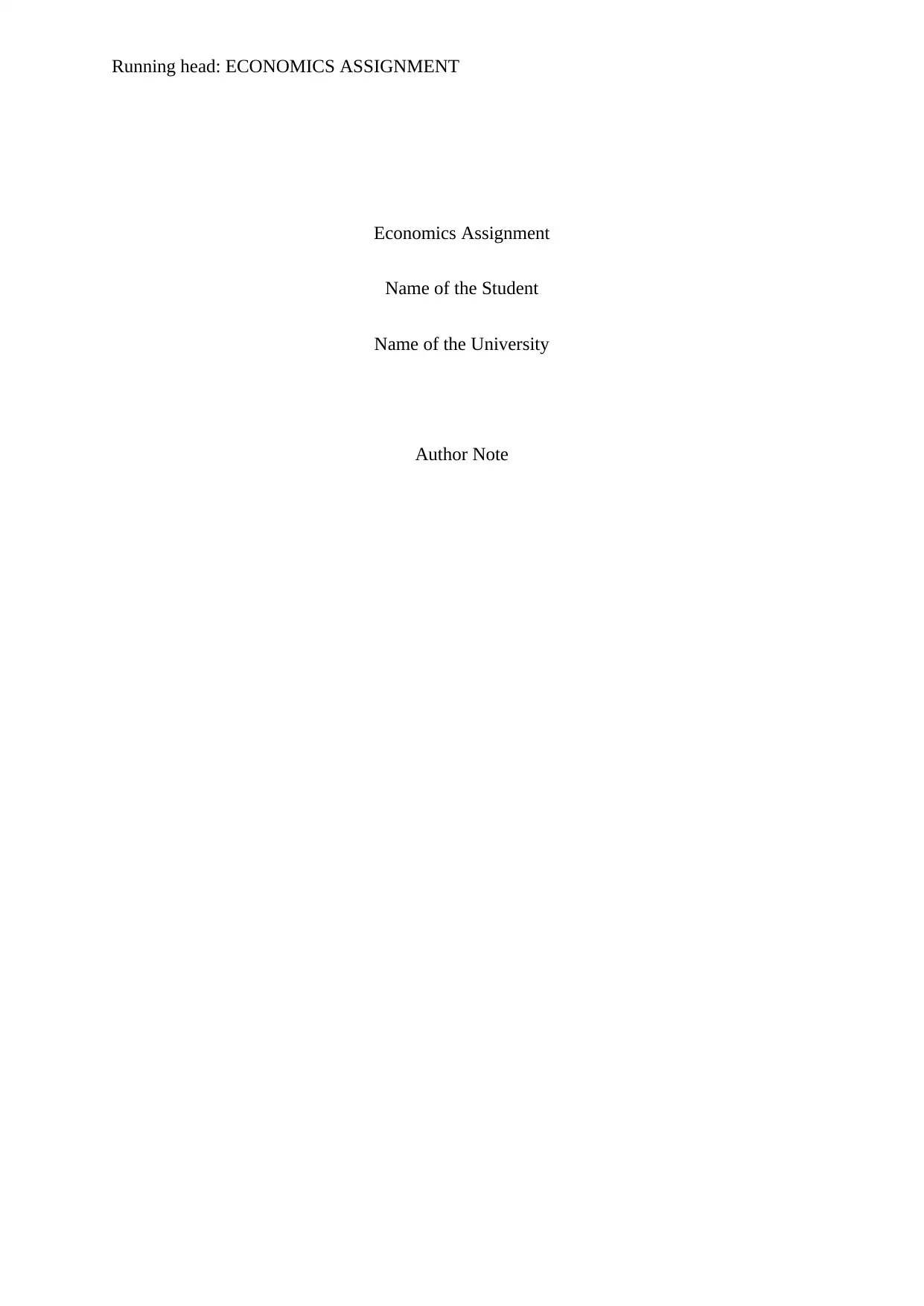
Running head: ECONOMICS ASSIGNMENT
Economics Assignment
Name of the Student
Name of the University
Author Note
Economics Assignment
Name of the Student
Name of the University
Author Note
Paraphrase This Document
Need a fresh take? Get an instant paraphrase of this document with our AI Paraphraser
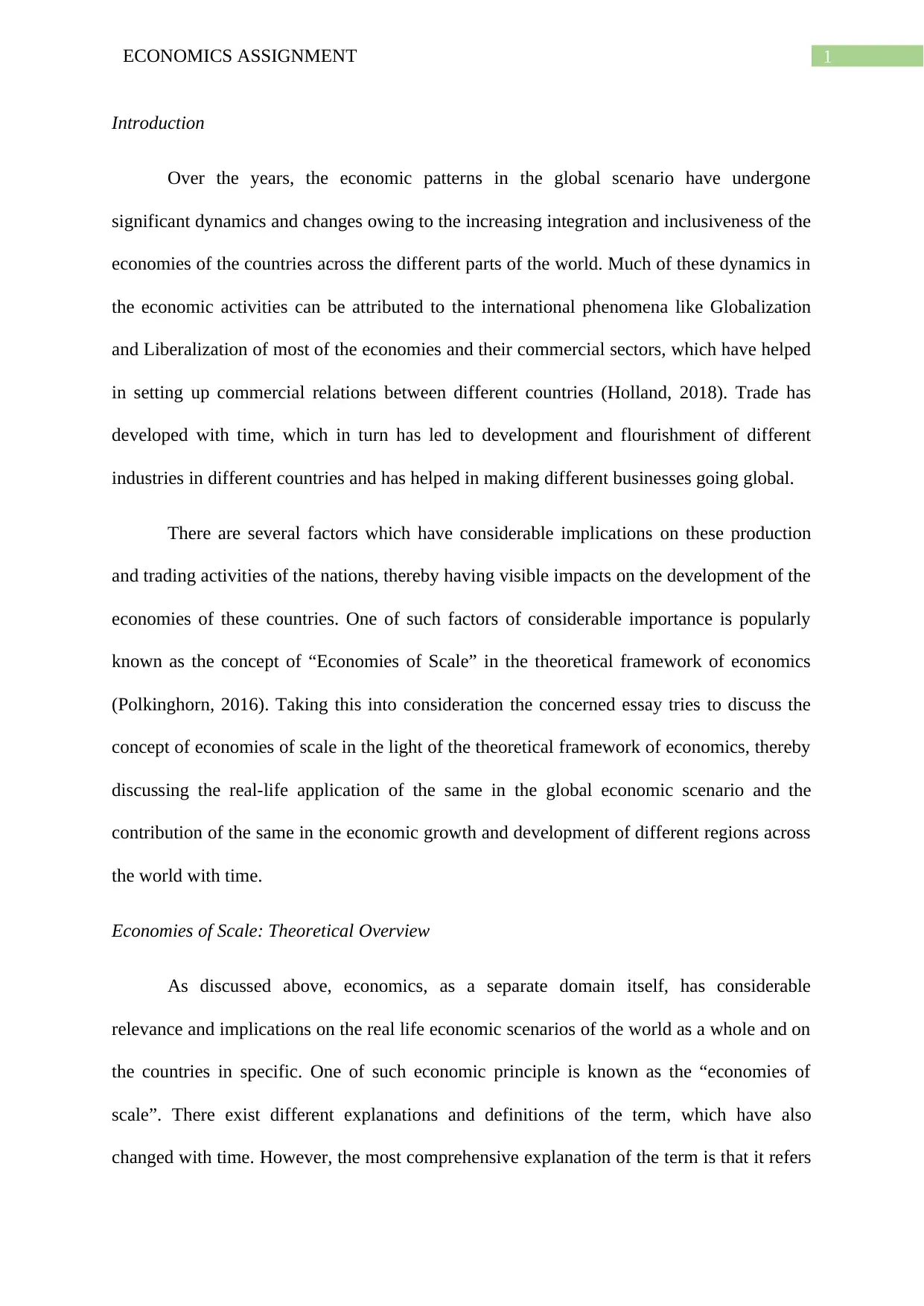
1ECONOMICS ASSIGNMENT
Introduction
Over the years, the economic patterns in the global scenario have undergone
significant dynamics and changes owing to the increasing integration and inclusiveness of the
economies of the countries across the different parts of the world. Much of these dynamics in
the economic activities can be attributed to the international phenomena like Globalization
and Liberalization of most of the economies and their commercial sectors, which have helped
in setting up commercial relations between different countries (Holland, 2018). Trade has
developed with time, which in turn has led to development and flourishment of different
industries in different countries and has helped in making different businesses going global.
There are several factors which have considerable implications on these production
and trading activities of the nations, thereby having visible impacts on the development of the
economies of these countries. One of such factors of considerable importance is popularly
known as the concept of “Economies of Scale” in the theoretical framework of economics
(Polkinghorn, 2016). Taking this into consideration the concerned essay tries to discuss the
concept of economies of scale in the light of the theoretical framework of economics, thereby
discussing the real-life application of the same in the global economic scenario and the
contribution of the same in the economic growth and development of different regions across
the world with time.
Economies of Scale: Theoretical Overview
As discussed above, economics, as a separate domain itself, has considerable
relevance and implications on the real life economic scenarios of the world as a whole and on
the countries in specific. One of such economic principle is known as the “economies of
scale”. There exist different explanations and definitions of the term, which have also
changed with time. However, the most comprehensive explanation of the term is that it refers
Introduction
Over the years, the economic patterns in the global scenario have undergone
significant dynamics and changes owing to the increasing integration and inclusiveness of the
economies of the countries across the different parts of the world. Much of these dynamics in
the economic activities can be attributed to the international phenomena like Globalization
and Liberalization of most of the economies and their commercial sectors, which have helped
in setting up commercial relations between different countries (Holland, 2018). Trade has
developed with time, which in turn has led to development and flourishment of different
industries in different countries and has helped in making different businesses going global.
There are several factors which have considerable implications on these production
and trading activities of the nations, thereby having visible impacts on the development of the
economies of these countries. One of such factors of considerable importance is popularly
known as the concept of “Economies of Scale” in the theoretical framework of economics
(Polkinghorn, 2016). Taking this into consideration the concerned essay tries to discuss the
concept of economies of scale in the light of the theoretical framework of economics, thereby
discussing the real-life application of the same in the global economic scenario and the
contribution of the same in the economic growth and development of different regions across
the world with time.
Economies of Scale: Theoretical Overview
As discussed above, economics, as a separate domain itself, has considerable
relevance and implications on the real life economic scenarios of the world as a whole and on
the countries in specific. One of such economic principle is known as the “economies of
scale”. There exist different explanations and definitions of the term, which have also
changed with time. However, the most comprehensive explanation of the term is that it refers

2ECONOMICS ASSIGNMENT
to the advantages in terms of cost of production, which a producer or a firm enjoys with
increase in the level of output with time (Carlino, 2012).
To understand the concept of economies of scale and how it works it is important to
know about the structure of the cost of production of goods and services which is usually
incurred by the company. There are usually two types of costs incurred by a firm while
carrying out the production activities (Baumol & Blinder, 2015). These costs are:
Fixed cost- There are several costs which are incurred by the producers in their production
process, which do not depend on the number of units of output produced by the company.
These costs remain constant usually though a relevant range of production. Examples of such
costs are rent, machineries, plants and similar other factors of production.
Variable cost- These costs incurred by the firms in their production processes depend on the
number of units of output produced by the firms. In general, the variable cost of production
increase with the increase in the production of outputs, the rate of change varying with time.
The primary examples of variable costs of production are those of wages, cost of buying
intermediate materials and inputs required for production, utilities and similar commodities
(Hall & Lieberman, 2012).
Therefore, total cost of production of goods and services can be shown as follows:
Total Cost (TC) = Total Fixed Cost (TFC)+Total Variable Cost (TVC)
Thus, as the producers start with their production activities, initially the fixed cost of
production may seem to be high in many cases. However, with the increase in the number of
units of output, the average fixed cost goes on decreasing (Harrison, 2017). This can be
shown with the help of the following formula:
Average Cost of Production (AC) = Total Cost (TC)/Total Quantity (Q)
to the advantages in terms of cost of production, which a producer or a firm enjoys with
increase in the level of output with time (Carlino, 2012).
To understand the concept of economies of scale and how it works it is important to
know about the structure of the cost of production of goods and services which is usually
incurred by the company. There are usually two types of costs incurred by a firm while
carrying out the production activities (Baumol & Blinder, 2015). These costs are:
Fixed cost- There are several costs which are incurred by the producers in their production
process, which do not depend on the number of units of output produced by the company.
These costs remain constant usually though a relevant range of production. Examples of such
costs are rent, machineries, plants and similar other factors of production.
Variable cost- These costs incurred by the firms in their production processes depend on the
number of units of output produced by the firms. In general, the variable cost of production
increase with the increase in the production of outputs, the rate of change varying with time.
The primary examples of variable costs of production are those of wages, cost of buying
intermediate materials and inputs required for production, utilities and similar commodities
(Hall & Lieberman, 2012).
Therefore, total cost of production of goods and services can be shown as follows:
Total Cost (TC) = Total Fixed Cost (TFC)+Total Variable Cost (TVC)
Thus, as the producers start with their production activities, initially the fixed cost of
production may seem to be high in many cases. However, with the increase in the number of
units of output, the average fixed cost goes on decreasing (Harrison, 2017). This can be
shown with the help of the following formula:
Average Cost of Production (AC) = Total Cost (TC)/Total Quantity (Q)
⊘ This is a preview!⊘
Do you want full access?
Subscribe today to unlock all pages.

Trusted by 1+ million students worldwide
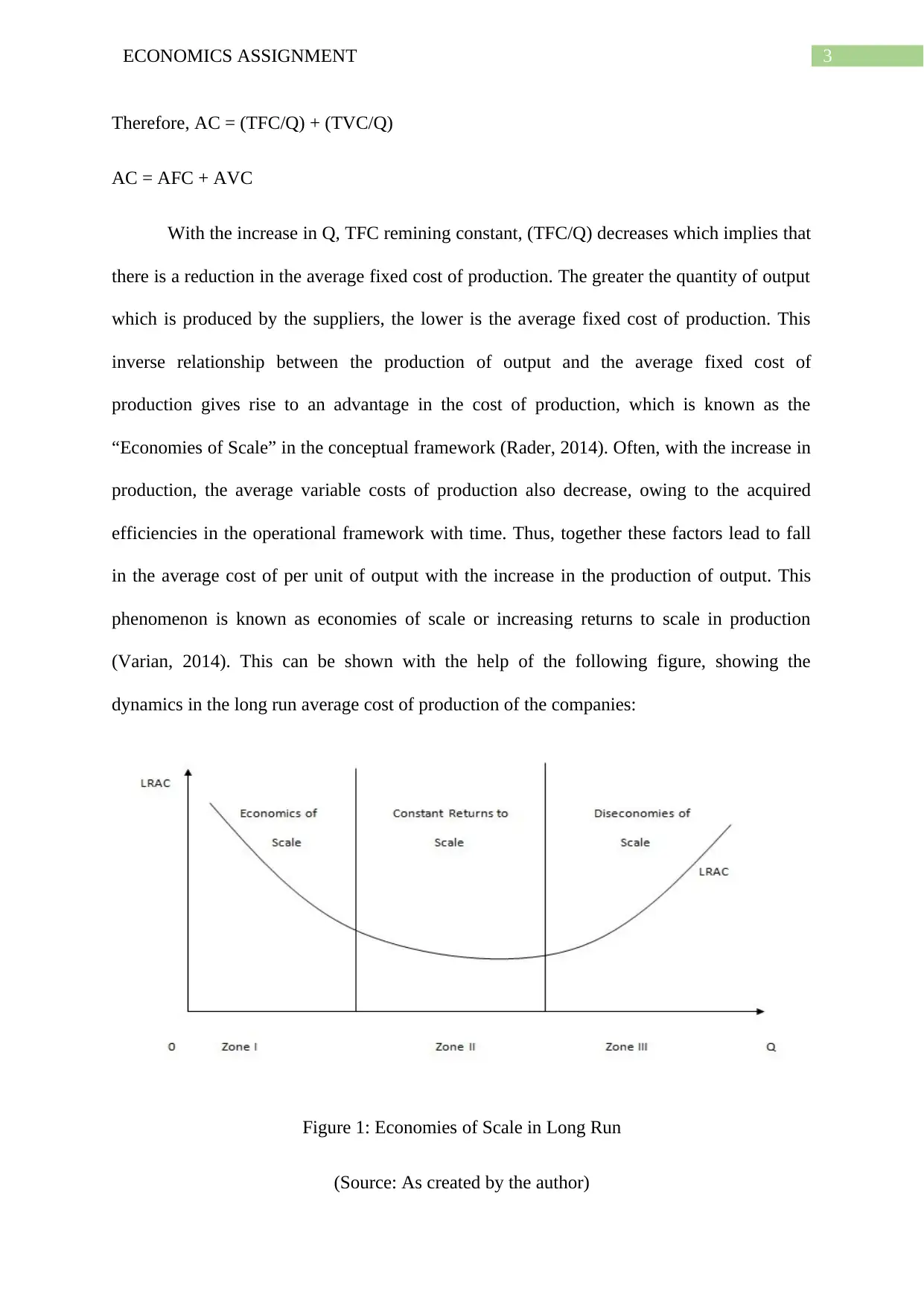
3ECONOMICS ASSIGNMENT
Therefore, AC = (TFC/Q) + (TVC/Q)
AC = AFC + AVC
With the increase in Q, TFC remining constant, (TFC/Q) decreases which implies that
there is a reduction in the average fixed cost of production. The greater the quantity of output
which is produced by the suppliers, the lower is the average fixed cost of production. This
inverse relationship between the production of output and the average fixed cost of
production gives rise to an advantage in the cost of production, which is known as the
“Economies of Scale” in the conceptual framework (Rader, 2014). Often, with the increase in
production, the average variable costs of production also decrease, owing to the acquired
efficiencies in the operational framework with time. Thus, together these factors lead to fall
in the average cost of per unit of output with the increase in the production of output. This
phenomenon is known as economies of scale or increasing returns to scale in production
(Varian, 2014). This can be shown with the help of the following figure, showing the
dynamics in the long run average cost of production of the companies:
Figure 1: Economies of Scale in Long Run
(Source: As created by the author)
Therefore, AC = (TFC/Q) + (TVC/Q)
AC = AFC + AVC
With the increase in Q, TFC remining constant, (TFC/Q) decreases which implies that
there is a reduction in the average fixed cost of production. The greater the quantity of output
which is produced by the suppliers, the lower is the average fixed cost of production. This
inverse relationship between the production of output and the average fixed cost of
production gives rise to an advantage in the cost of production, which is known as the
“Economies of Scale” in the conceptual framework (Rader, 2014). Often, with the increase in
production, the average variable costs of production also decrease, owing to the acquired
efficiencies in the operational framework with time. Thus, together these factors lead to fall
in the average cost of per unit of output with the increase in the production of output. This
phenomenon is known as economies of scale or increasing returns to scale in production
(Varian, 2014). This can be shown with the help of the following figure, showing the
dynamics in the long run average cost of production of the companies:
Figure 1: Economies of Scale in Long Run
(Source: As created by the author)
Paraphrase This Document
Need a fresh take? Get an instant paraphrase of this document with our AI Paraphraser
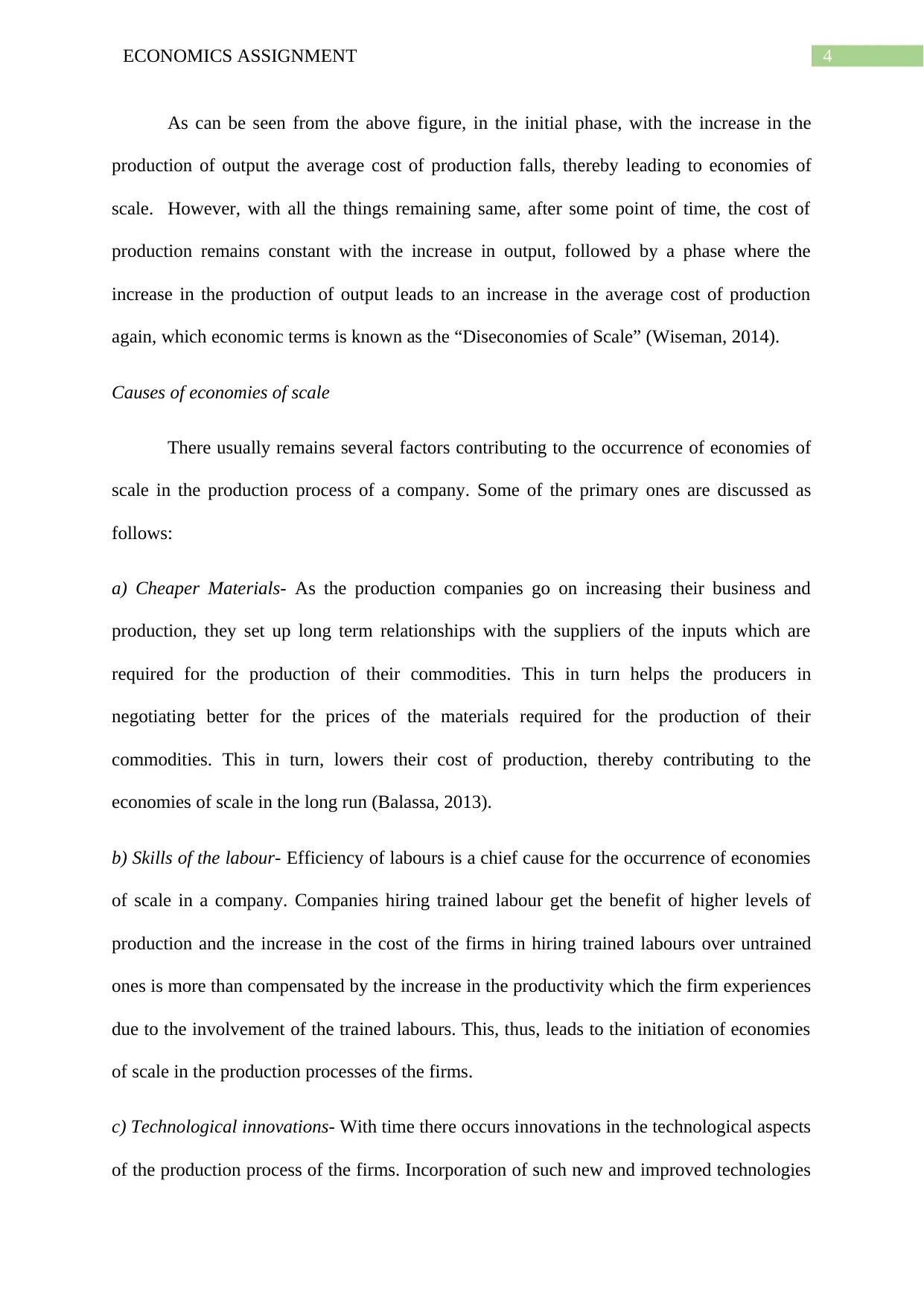
4ECONOMICS ASSIGNMENT
As can be seen from the above figure, in the initial phase, with the increase in the
production of output the average cost of production falls, thereby leading to economies of
scale. However, with all the things remaining same, after some point of time, the cost of
production remains constant with the increase in output, followed by a phase where the
increase in the production of output leads to an increase in the average cost of production
again, which economic terms is known as the “Diseconomies of Scale” (Wiseman, 2014).
Causes of economies of scale
There usually remains several factors contributing to the occurrence of economies of
scale in the production process of a company. Some of the primary ones are discussed as
follows:
a) Cheaper Materials- As the production companies go on increasing their business and
production, they set up long term relationships with the suppliers of the inputs which are
required for the production of their commodities. This in turn helps the producers in
negotiating better for the prices of the materials required for the production of their
commodities. This in turn, lowers their cost of production, thereby contributing to the
economies of scale in the long run (Balassa, 2013).
b) Skills of the labour- Efficiency of labours is a chief cause for the occurrence of economies
of scale in a company. Companies hiring trained labour get the benefit of higher levels of
production and the increase in the cost of the firms in hiring trained labours over untrained
ones is more than compensated by the increase in the productivity which the firm experiences
due to the involvement of the trained labours. This, thus, leads to the initiation of economies
of scale in the production processes of the firms.
c) Technological innovations- With time there occurs innovations in the technological aspects
of the production process of the firms. Incorporation of such new and improved technologies
As can be seen from the above figure, in the initial phase, with the increase in the
production of output the average cost of production falls, thereby leading to economies of
scale. However, with all the things remaining same, after some point of time, the cost of
production remains constant with the increase in output, followed by a phase where the
increase in the production of output leads to an increase in the average cost of production
again, which economic terms is known as the “Diseconomies of Scale” (Wiseman, 2014).
Causes of economies of scale
There usually remains several factors contributing to the occurrence of economies of
scale in the production process of a company. Some of the primary ones are discussed as
follows:
a) Cheaper Materials- As the production companies go on increasing their business and
production, they set up long term relationships with the suppliers of the inputs which are
required for the production of their commodities. This in turn helps the producers in
negotiating better for the prices of the materials required for the production of their
commodities. This in turn, lowers their cost of production, thereby contributing to the
economies of scale in the long run (Balassa, 2013).
b) Skills of the labour- Efficiency of labours is a chief cause for the occurrence of economies
of scale in a company. Companies hiring trained labour get the benefit of higher levels of
production and the increase in the cost of the firms in hiring trained labours over untrained
ones is more than compensated by the increase in the productivity which the firm experiences
due to the involvement of the trained labours. This, thus, leads to the initiation of economies
of scale in the production processes of the firms.
c) Technological innovations- With time there occurs innovations in the technological aspects
of the production process of the firms. Incorporation of such new and improved technologies
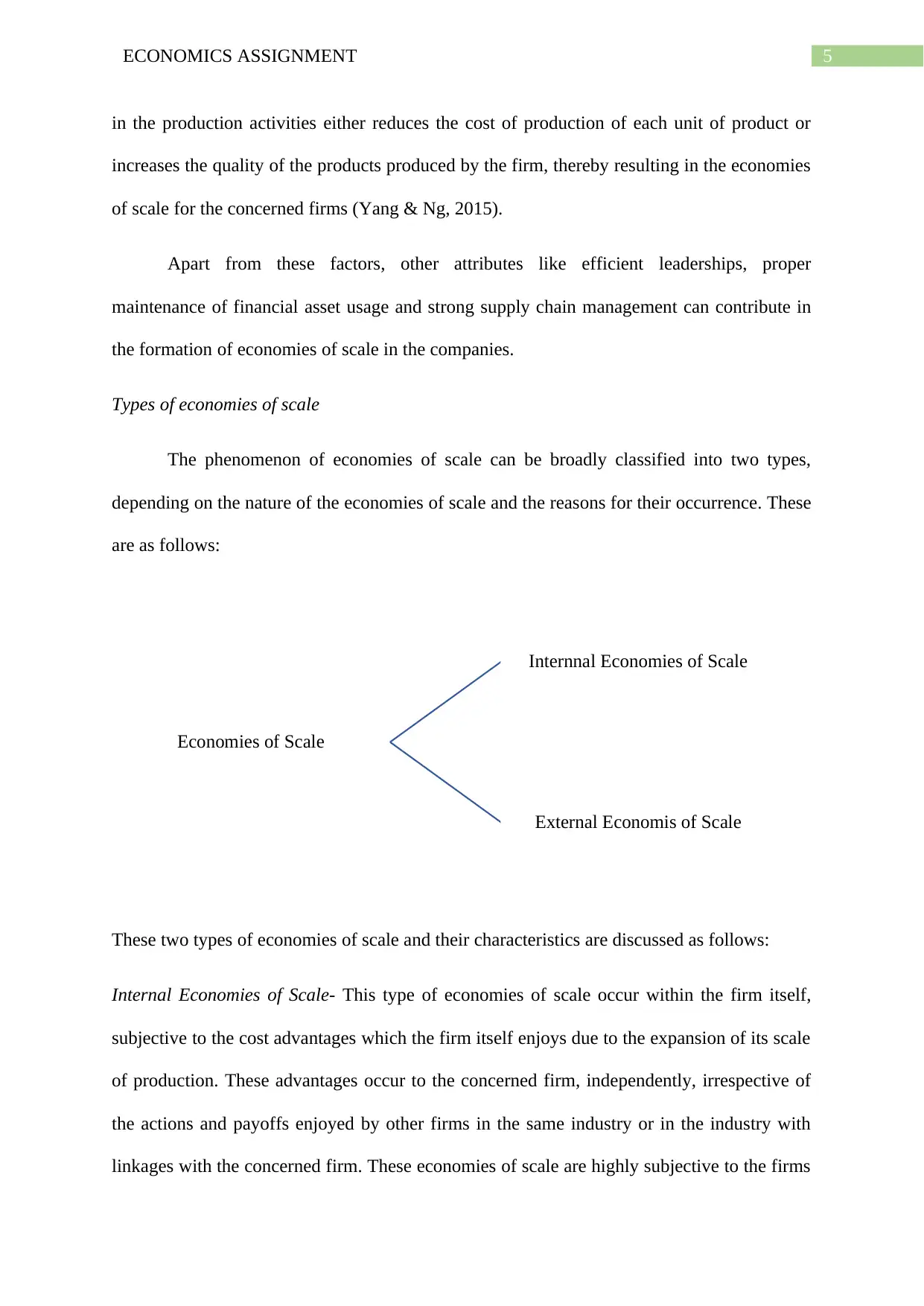
5ECONOMICS ASSIGNMENT
in the production activities either reduces the cost of production of each unit of product or
increases the quality of the products produced by the firm, thereby resulting in the economies
of scale for the concerned firms (Yang & Ng, 2015).
Apart from these factors, other attributes like efficient leaderships, proper
maintenance of financial asset usage and strong supply chain management can contribute in
the formation of economies of scale in the companies.
Types of economies of scale
The phenomenon of economies of scale can be broadly classified into two types,
depending on the nature of the economies of scale and the reasons for their occurrence. These
are as follows:
These two types of economies of scale and their characteristics are discussed as follows:
Internal Economies of Scale- This type of economies of scale occur within the firm itself,
subjective to the cost advantages which the firm itself enjoys due to the expansion of its scale
of production. These advantages occur to the concerned firm, independently, irrespective of
the actions and payoffs enjoyed by other firms in the same industry or in the industry with
linkages with the concerned firm. These economies of scale are highly subjective to the firms
Economies of Scale
Internnal Economies of Scale
External Economis of Scale
in the production activities either reduces the cost of production of each unit of product or
increases the quality of the products produced by the firm, thereby resulting in the economies
of scale for the concerned firms (Yang & Ng, 2015).
Apart from these factors, other attributes like efficient leaderships, proper
maintenance of financial asset usage and strong supply chain management can contribute in
the formation of economies of scale in the companies.
Types of economies of scale
The phenomenon of economies of scale can be broadly classified into two types,
depending on the nature of the economies of scale and the reasons for their occurrence. These
are as follows:
These two types of economies of scale and their characteristics are discussed as follows:
Internal Economies of Scale- This type of economies of scale occur within the firm itself,
subjective to the cost advantages which the firm itself enjoys due to the expansion of its scale
of production. These advantages occur to the concerned firm, independently, irrespective of
the actions and payoffs enjoyed by other firms in the same industry or in the industry with
linkages with the concerned firm. These economies of scale are highly subjective to the firms
Economies of Scale
Internnal Economies of Scale
External Economis of Scale
⊘ This is a preview!⊘
Do you want full access?
Subscribe today to unlock all pages.

Trusted by 1+ million students worldwide

6ECONOMICS ASSIGNMENT
experiencing the same and are not results of any kind of broad innovations or changes in the
structure of overall production processes ("Economies of Scale - Definition, Types, Effects of
Economies of Scale", 2018).
The main types of internal economies of scale are as follows:
a) Technical Economies of Scale- A firm enjoys this type of internal economies of scale by
incorporating better technologies, better machines and production increasing techniques,
which leads an increase in the production and a simultaneous decrease in the average cost of
production.
b) Economies of By-Products Usage- Often the by-products which come out in the process of
production of a commodity can be used by the firms for different purposes or are sold by the
firms to some other producers or consumers, thereby increasing the economic advantages of
the production of that particular commodity.
c) Labour Economies of Scale- There remains a large number of workers in the production
process of large firms, each having different types of talents and skills. Division of work
responsibilities and allocation of works to the labours according to their skills can lead to
specialization, which by saving time and encouraging inventions in different domains leads to
an overall cost of production (Kemeny & Storper, 2015).
d) Economies of research and development- The innovative attitude of the research and
development teams present in the companies often help them in building and implementing
innovative processes which help in cutting the cost of production of goods and services
without compromising on the qualities. This in turn leads to the occurrence of economies of
scale.
External Economies of Scale- These types of economies of scale refer to the cost advantages
or other forms of economic gains which are enjoyed by all the firms in a particular industry
experiencing the same and are not results of any kind of broad innovations or changes in the
structure of overall production processes ("Economies of Scale - Definition, Types, Effects of
Economies of Scale", 2018).
The main types of internal economies of scale are as follows:
a) Technical Economies of Scale- A firm enjoys this type of internal economies of scale by
incorporating better technologies, better machines and production increasing techniques,
which leads an increase in the production and a simultaneous decrease in the average cost of
production.
b) Economies of By-Products Usage- Often the by-products which come out in the process of
production of a commodity can be used by the firms for different purposes or are sold by the
firms to some other producers or consumers, thereby increasing the economic advantages of
the production of that particular commodity.
c) Labour Economies of Scale- There remains a large number of workers in the production
process of large firms, each having different types of talents and skills. Division of work
responsibilities and allocation of works to the labours according to their skills can lead to
specialization, which by saving time and encouraging inventions in different domains leads to
an overall cost of production (Kemeny & Storper, 2015).
d) Economies of research and development- The innovative attitude of the research and
development teams present in the companies often help them in building and implementing
innovative processes which help in cutting the cost of production of goods and services
without compromising on the qualities. This in turn leads to the occurrence of economies of
scale.
External Economies of Scale- These types of economies of scale refer to the cost advantages
or other forms of economic gains which are enjoyed by all the firms in a particular industry
Paraphrase This Document
Need a fresh take? Get an instant paraphrase of this document with our AI Paraphraser
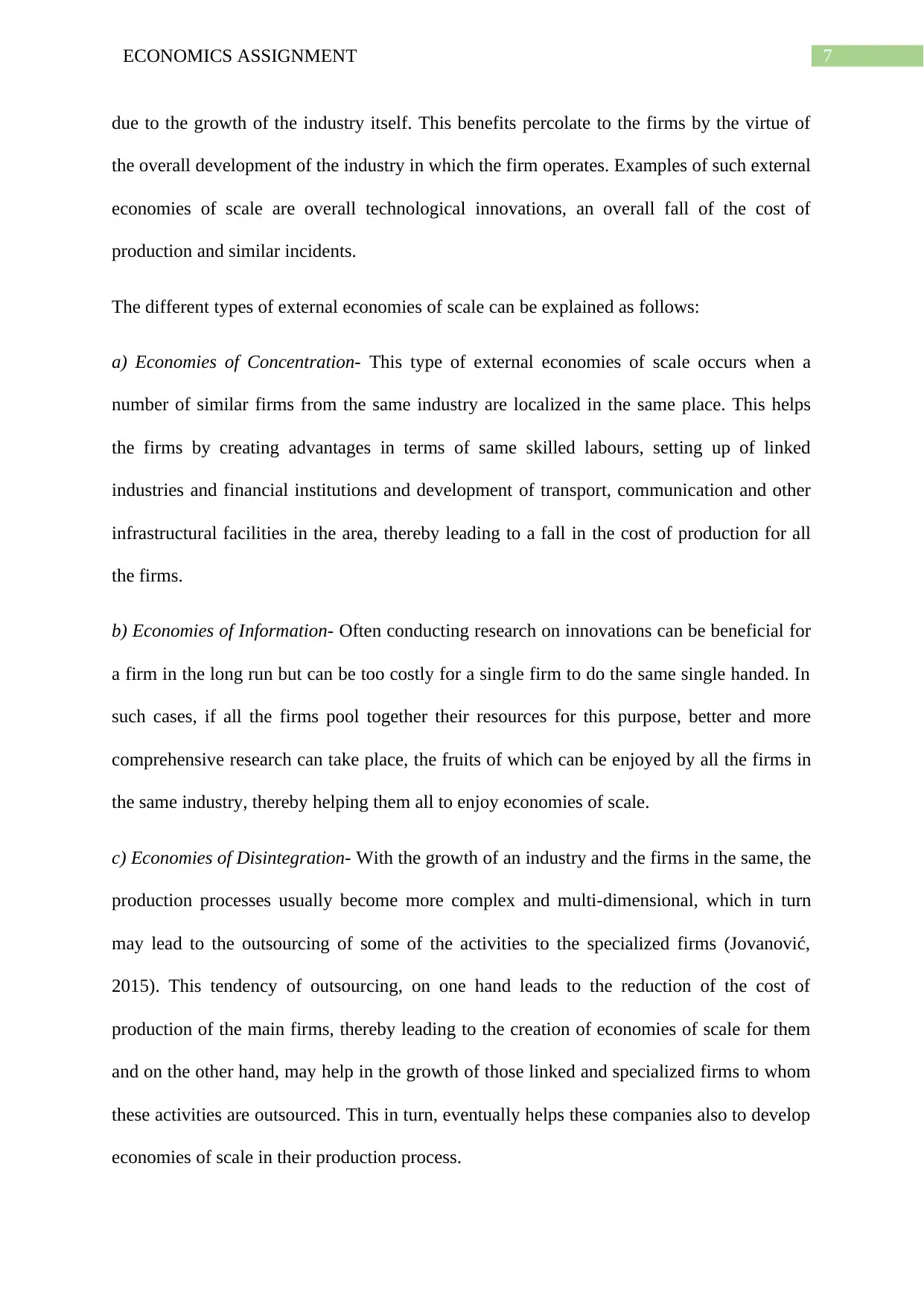
7ECONOMICS ASSIGNMENT
due to the growth of the industry itself. This benefits percolate to the firms by the virtue of
the overall development of the industry in which the firm operates. Examples of such external
economies of scale are overall technological innovations, an overall fall of the cost of
production and similar incidents.
The different types of external economies of scale can be explained as follows:
a) Economies of Concentration- This type of external economies of scale occurs when a
number of similar firms from the same industry are localized in the same place. This helps
the firms by creating advantages in terms of same skilled labours, setting up of linked
industries and financial institutions and development of transport, communication and other
infrastructural facilities in the area, thereby leading to a fall in the cost of production for all
the firms.
b) Economies of Information- Often conducting research on innovations can be beneficial for
a firm in the long run but can be too costly for a single firm to do the same single handed. In
such cases, if all the firms pool together their resources for this purpose, better and more
comprehensive research can take place, the fruits of which can be enjoyed by all the firms in
the same industry, thereby helping them all to enjoy economies of scale.
c) Economies of Disintegration- With the growth of an industry and the firms in the same, the
production processes usually become more complex and multi-dimensional, which in turn
may lead to the outsourcing of some of the activities to the specialized firms (Jovanović,
2015). This tendency of outsourcing, on one hand leads to the reduction of the cost of
production of the main firms, thereby leading to the creation of economies of scale for them
and on the other hand, may help in the growth of those linked and specialized firms to whom
these activities are outsourced. This in turn, eventually helps these companies also to develop
economies of scale in their production process.
due to the growth of the industry itself. This benefits percolate to the firms by the virtue of
the overall development of the industry in which the firm operates. Examples of such external
economies of scale are overall technological innovations, an overall fall of the cost of
production and similar incidents.
The different types of external economies of scale can be explained as follows:
a) Economies of Concentration- This type of external economies of scale occurs when a
number of similar firms from the same industry are localized in the same place. This helps
the firms by creating advantages in terms of same skilled labours, setting up of linked
industries and financial institutions and development of transport, communication and other
infrastructural facilities in the area, thereby leading to a fall in the cost of production for all
the firms.
b) Economies of Information- Often conducting research on innovations can be beneficial for
a firm in the long run but can be too costly for a single firm to do the same single handed. In
such cases, if all the firms pool together their resources for this purpose, better and more
comprehensive research can take place, the fruits of which can be enjoyed by all the firms in
the same industry, thereby helping them all to enjoy economies of scale.
c) Economies of Disintegration- With the growth of an industry and the firms in the same, the
production processes usually become more complex and multi-dimensional, which in turn
may lead to the outsourcing of some of the activities to the specialized firms (Jovanović,
2015). This tendency of outsourcing, on one hand leads to the reduction of the cost of
production of the main firms, thereby leading to the creation of economies of scale for them
and on the other hand, may help in the growth of those linked and specialized firms to whom
these activities are outsourced. This in turn, eventually helps these companies also to develop
economies of scale in their production process.

8ECONOMICS ASSIGNMENT
The internal and external economies of scale are however related to each other and there lies
bilateral cause and effect relationships between the same, thereby leading to a comprehensive
and integrated growth of the firms individually and to an overall growth of the industry as a
whole.
Application of the concept of economies of scale in economic development of regions
The concept of economies of scale and its implications on the development of
economies across the world, was first proposed by Adam Smith. Adam Smith tried to explain
the concept of economies of scale in terms of specialization of labour and their implications
in the increase in the productivity, thereby on the overall development of the economies
(Lewis, 2013).
According to his assertions, as the companies increase their production activities, they
hire more labours, which in turn leads to the scopes of dividing and sub-dividing the different
activities and allocating the same to the workers on the basis of their skills and capabilities.
This enables the workers to concentrate on the tasks assigned to them more efficiently as they
have lesser varieties of task to perform (Freeman, 2013). The workers eventually develop
special skills in the jobs which they perform, which enables them to perform their task much
more efficiently than any other worker. This overall increase in the efficiency in the
production process helps the firms in saving time as well as cost of production, thereby
leading to economies of scale.
The application of economies of scale in trade can be seen to be proposed by David
Ricardo, who in his Competitive Advantage Theory asserts that if the countries concentrate
on the production of only those commodities and services in which they have specialized
resources and which they can produce at lower costs than other countries and can exchange
The internal and external economies of scale are however related to each other and there lies
bilateral cause and effect relationships between the same, thereby leading to a comprehensive
and integrated growth of the firms individually and to an overall growth of the industry as a
whole.
Application of the concept of economies of scale in economic development of regions
The concept of economies of scale and its implications on the development of
economies across the world, was first proposed by Adam Smith. Adam Smith tried to explain
the concept of economies of scale in terms of specialization of labour and their implications
in the increase in the productivity, thereby on the overall development of the economies
(Lewis, 2013).
According to his assertions, as the companies increase their production activities, they
hire more labours, which in turn leads to the scopes of dividing and sub-dividing the different
activities and allocating the same to the workers on the basis of their skills and capabilities.
This enables the workers to concentrate on the tasks assigned to them more efficiently as they
have lesser varieties of task to perform (Freeman, 2013). The workers eventually develop
special skills in the jobs which they perform, which enables them to perform their task much
more efficiently than any other worker. This overall increase in the efficiency in the
production process helps the firms in saving time as well as cost of production, thereby
leading to economies of scale.
The application of economies of scale in trade can be seen to be proposed by David
Ricardo, who in his Competitive Advantage Theory asserts that if the countries concentrate
on the production of only those commodities and services in which they have specialized
resources and which they can produce at lower costs than other countries and can exchange
⊘ This is a preview!⊘
Do you want full access?
Subscribe today to unlock all pages.

Trusted by 1+ million students worldwide
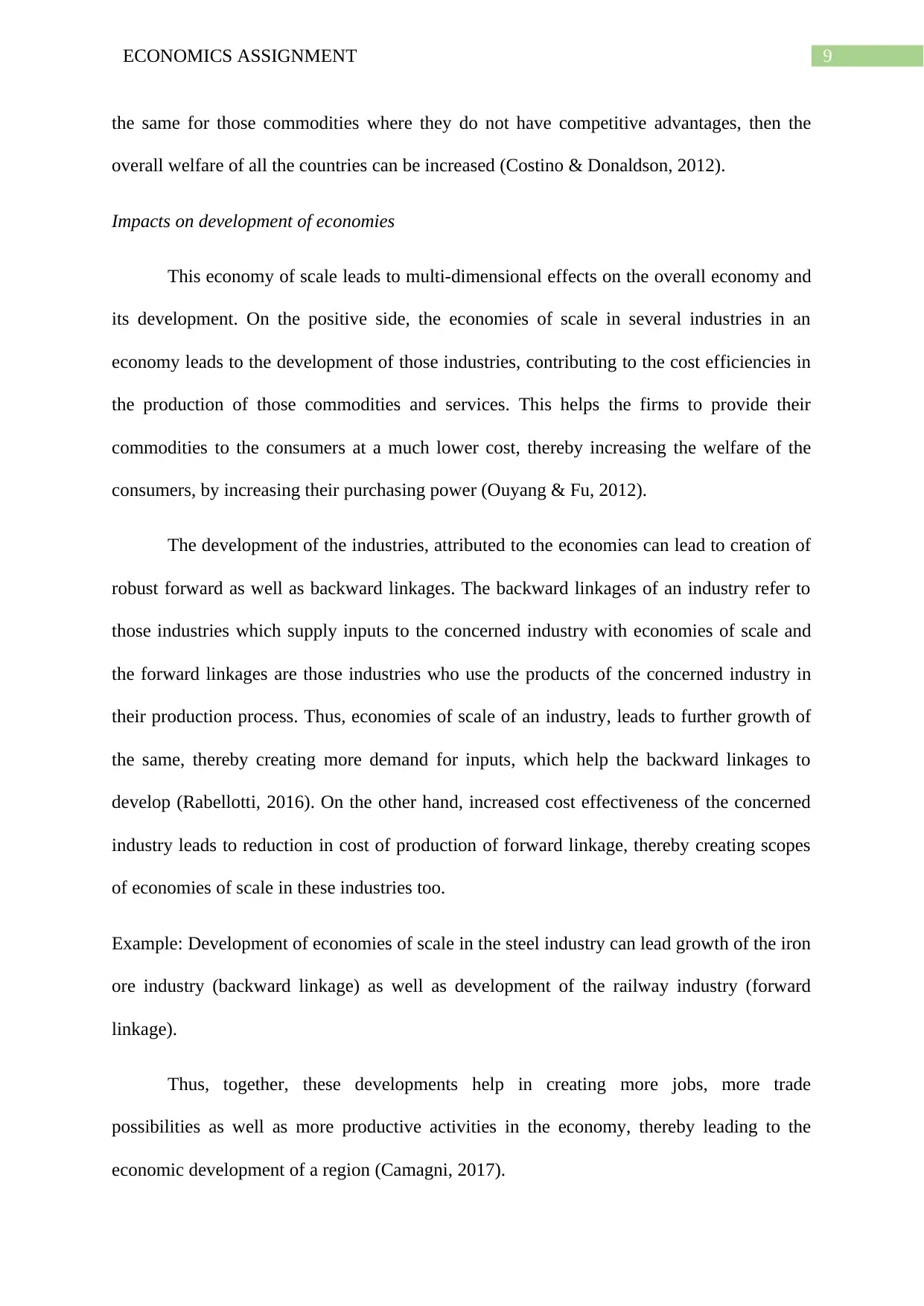
9ECONOMICS ASSIGNMENT
the same for those commodities where they do not have competitive advantages, then the
overall welfare of all the countries can be increased (Costino & Donaldson, 2012).
Impacts on development of economies
This economy of scale leads to multi-dimensional effects on the overall economy and
its development. On the positive side, the economies of scale in several industries in an
economy leads to the development of those industries, contributing to the cost efficiencies in
the production of those commodities and services. This helps the firms to provide their
commodities to the consumers at a much lower cost, thereby increasing the welfare of the
consumers, by increasing their purchasing power (Ouyang & Fu, 2012).
The development of the industries, attributed to the economies can lead to creation of
robust forward as well as backward linkages. The backward linkages of an industry refer to
those industries which supply inputs to the concerned industry with economies of scale and
the forward linkages are those industries who use the products of the concerned industry in
their production process. Thus, economies of scale of an industry, leads to further growth of
the same, thereby creating more demand for inputs, which help the backward linkages to
develop (Rabellotti, 2016). On the other hand, increased cost effectiveness of the concerned
industry leads to reduction in cost of production of forward linkage, thereby creating scopes
of economies of scale in these industries too.
Example: Development of economies of scale in the steel industry can lead growth of the iron
ore industry (backward linkage) as well as development of the railway industry (forward
linkage).
Thus, together, these developments help in creating more jobs, more trade
possibilities as well as more productive activities in the economy, thereby leading to the
economic development of a region (Camagni, 2017).
the same for those commodities where they do not have competitive advantages, then the
overall welfare of all the countries can be increased (Costino & Donaldson, 2012).
Impacts on development of economies
This economy of scale leads to multi-dimensional effects on the overall economy and
its development. On the positive side, the economies of scale in several industries in an
economy leads to the development of those industries, contributing to the cost efficiencies in
the production of those commodities and services. This helps the firms to provide their
commodities to the consumers at a much lower cost, thereby increasing the welfare of the
consumers, by increasing their purchasing power (Ouyang & Fu, 2012).
The development of the industries, attributed to the economies can lead to creation of
robust forward as well as backward linkages. The backward linkages of an industry refer to
those industries which supply inputs to the concerned industry with economies of scale and
the forward linkages are those industries who use the products of the concerned industry in
their production process. Thus, economies of scale of an industry, leads to further growth of
the same, thereby creating more demand for inputs, which help the backward linkages to
develop (Rabellotti, 2016). On the other hand, increased cost effectiveness of the concerned
industry leads to reduction in cost of production of forward linkage, thereby creating scopes
of economies of scale in these industries too.
Example: Development of economies of scale in the steel industry can lead growth of the iron
ore industry (backward linkage) as well as development of the railway industry (forward
linkage).
Thus, together, these developments help in creating more jobs, more trade
possibilities as well as more productive activities in the economy, thereby leading to the
economic development of a region (Camagni, 2017).
Paraphrase This Document
Need a fresh take? Get an instant paraphrase of this document with our AI Paraphraser

10ECONOMICS ASSIGNMENT
However, often the creation of economies of scale in some firms in an industry, lead
to the increase in their power, competencies and market shares, thereby threatening the small
firms in the same industry. Many small firms move out of the market, which reduces the
competition in the industries, increasing the monopoly powers of the big ones. This may be
detrimental for the economic development of the regions, in terms of loss of consumer’s
welfare as well as loss of potential firms and production scopes.
Conclusion
The phenomenon of economies of scale is considerably relevant to the production
activities of the firms and industries in all parts of the world over the years. The effects of
economies of scale can be wide ranged. While the positive effects lead to overall
development of production sectors of an economy, increase in the consumer’s welfare,
thereby contributing to the growth of the economies, the negative effects can lead to unfair
competitions, monopolistic trends, high prices and loss of consumer’s welfare, thereby
hampering the development of the regions to some extent.
However, often the creation of economies of scale in some firms in an industry, lead
to the increase in their power, competencies and market shares, thereby threatening the small
firms in the same industry. Many small firms move out of the market, which reduces the
competition in the industries, increasing the monopoly powers of the big ones. This may be
detrimental for the economic development of the regions, in terms of loss of consumer’s
welfare as well as loss of potential firms and production scopes.
Conclusion
The phenomenon of economies of scale is considerably relevant to the production
activities of the firms and industries in all parts of the world over the years. The effects of
economies of scale can be wide ranged. While the positive effects lead to overall
development of production sectors of an economy, increase in the consumer’s welfare,
thereby contributing to the growth of the economies, the negative effects can lead to unfair
competitions, monopolistic trends, high prices and loss of consumer’s welfare, thereby
hampering the development of the regions to some extent.
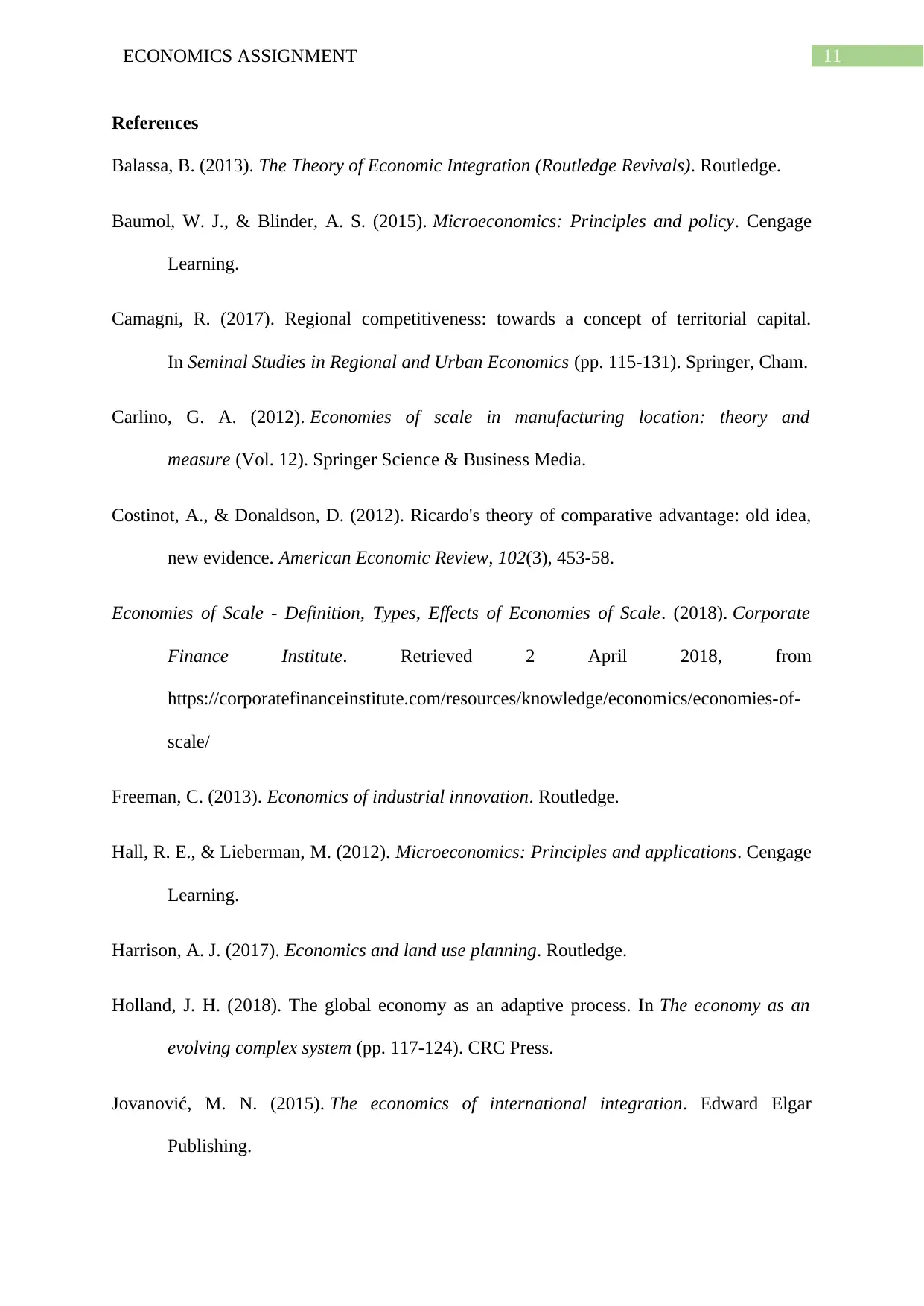
11ECONOMICS ASSIGNMENT
References
Balassa, B. (2013). The Theory of Economic Integration (Routledge Revivals). Routledge.
Baumol, W. J., & Blinder, A. S. (2015). Microeconomics: Principles and policy. Cengage
Learning.
Camagni, R. (2017). Regional competitiveness: towards a concept of territorial capital.
In Seminal Studies in Regional and Urban Economics (pp. 115-131). Springer, Cham.
Carlino, G. A. (2012). Economies of scale in manufacturing location: theory and
measure (Vol. 12). Springer Science & Business Media.
Costinot, A., & Donaldson, D. (2012). Ricardo's theory of comparative advantage: old idea,
new evidence. American Economic Review, 102(3), 453-58.
Economies of Scale - Definition, Types, Effects of Economies of Scale. (2018). Corporate
Finance Institute. Retrieved 2 April 2018, from
https://corporatefinanceinstitute.com/resources/knowledge/economics/economies-of-
scale/
Freeman, C. (2013). Economics of industrial innovation. Routledge.
Hall, R. E., & Lieberman, M. (2012). Microeconomics: Principles and applications. Cengage
Learning.
Harrison, A. J. (2017). Economics and land use planning. Routledge.
Holland, J. H. (2018). The global economy as an adaptive process. In The economy as an
evolving complex system (pp. 117-124). CRC Press.
Jovanović, M. N. (2015). The economics of international integration. Edward Elgar
Publishing.
References
Balassa, B. (2013). The Theory of Economic Integration (Routledge Revivals). Routledge.
Baumol, W. J., & Blinder, A. S. (2015). Microeconomics: Principles and policy. Cengage
Learning.
Camagni, R. (2017). Regional competitiveness: towards a concept of territorial capital.
In Seminal Studies in Regional and Urban Economics (pp. 115-131). Springer, Cham.
Carlino, G. A. (2012). Economies of scale in manufacturing location: theory and
measure (Vol. 12). Springer Science & Business Media.
Costinot, A., & Donaldson, D. (2012). Ricardo's theory of comparative advantage: old idea,
new evidence. American Economic Review, 102(3), 453-58.
Economies of Scale - Definition, Types, Effects of Economies of Scale. (2018). Corporate
Finance Institute. Retrieved 2 April 2018, from
https://corporatefinanceinstitute.com/resources/knowledge/economics/economies-of-
scale/
Freeman, C. (2013). Economics of industrial innovation. Routledge.
Hall, R. E., & Lieberman, M. (2012). Microeconomics: Principles and applications. Cengage
Learning.
Harrison, A. J. (2017). Economics and land use planning. Routledge.
Holland, J. H. (2018). The global economy as an adaptive process. In The economy as an
evolving complex system (pp. 117-124). CRC Press.
Jovanović, M. N. (2015). The economics of international integration. Edward Elgar
Publishing.
⊘ This is a preview!⊘
Do you want full access?
Subscribe today to unlock all pages.

Trusted by 1+ million students worldwide
1 out of 13
Related Documents
Your All-in-One AI-Powered Toolkit for Academic Success.
+13062052269
info@desklib.com
Available 24*7 on WhatsApp / Email
![[object Object]](/_next/static/media/star-bottom.7253800d.svg)
Unlock your academic potential
Copyright © 2020–2025 A2Z Services. All Rights Reserved. Developed and managed by ZUCOL.





